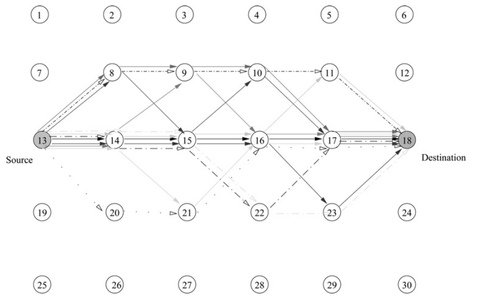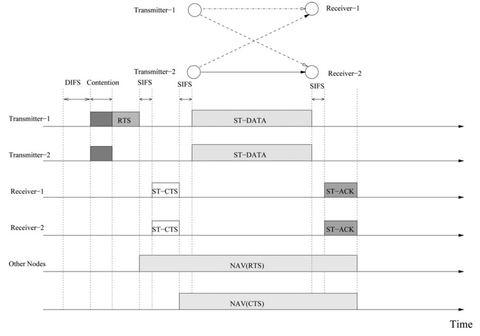Summary
In this study, the authors present a novel design framework aimed at developing ‘cooperative diversity’ in 802.11-based wireless sensor networks. The proposed scheme is a combination of a time-reversed space-time block code scheme at the physical layer and a cooperative routing protocol at the network layer. The core feature of this architecture is that the multiple routes are capable of assisting the transmission of each other, hence the reliability of ‘all’ the wireless links are enhanced simultaneously by cooperative diversity. This will involve the design of physical layer transmission schemes, medium access protocols and routing strategies. For the latter in particular, the authors present a cooperative routing protocol that is capable of exploiting full transmit diversity in wireless sensor networks. The authors restrict ourselves by imposing as few modifications to existing schemes as possible, so that integration to the existing infrastructure will be straightforward. Comprehensive simulations have been carried out to demonstrate the end-to-end performance of the proposed scheme. It is shown that a substantial gain can be achieved by cooperative diversity using a virtual multiple input multiple output system architecture.
Description
In order to address the challenges of cooperation, PHY layer cooperation schemes were proposed and, to a limited extent, medium access control (MAC) layer schemes. On the network layer, the network coding techniques can be viewed as a form of cooperation as well. To the best of our knowledge, there are very few designs that involve multiple layers for cooperative wireless sensor networks. Although the benefits of cooperation is partially achieved in one way or another, these designs have two main issues. Firstly, the relay selection process is implemented in the MAC layer, which would require a significant amount of control packets to provide handshakes between source/destination and relay nodes. Also, even a larger amount of control packets are necessary, when relays fail to deliver the packets. Secondly, the relays are prohibited from transmitting simultaneously, since the CSMA/CA protocol is invoked. Thus, only limited throughput enhancement could be achieved, given that the relays experience robust channel conditions. Cross-layer designs are proposed to combine cooperative diversity at the PHY layer with truncated Automatic Repeat-reQuest at the link layer to improve the throughput performance. Both schemes utilize cooperative diversity only if the destination node receives an erroneous packet from the source node.
In this work, our primary objective is to establish a multi-hop cooperative route from the source to the destination so that diversity can be achieved on a hop-by-hop basis through the entire cooperative path. As the result, the cooperative nodes will be systematically involved from the beginning, hence improving the first transmission attempt under fading channel conditions. The overall design structure is aimed at achieving full cooperative diversity, based on which the PHY, link and network layers of the system are specifically tailored.



